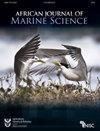在留尼汪岛(印度洋西南部)进行的双重标记实验估计了两头牛鲨Carcharhinus leucas的大规模运动和地点保真度
IF 1.4
4区 生物学
Q3 MARINE & FRESHWATER BIOLOGY
引用次数: 1
摘要
自2011年以来,留尼汪岛牛鲨每年平均被鲸鲨咬伤的次数显著增加。为了预测风险增加的区域和时期,我们需要更好地了解单个鲨鱼的空间利用动态。在留尼旺岛附近的沿海水域,使用弹出式卫星档案标签(PSAT)和声学发射器,对两头牛鲨(每种性别一条)进行了双重标记,并跟踪了174天(雄性)和139天(雌性)。这两条鲨鱼大部分时间都在近海度过(雄性为58.1%,雌性为89.9%)。雌性进行了短暂的短途旅行,但通常仍停留在近海。这只雄性动物时而在海岸停留,时而进行广泛的活动,包括前往距离该岛约210公里的一座海山附近进行一次大规模的公海旅行。这两条鲨鱼在居住地和栖息地范围上的差异可能反映了觅食和交配行为的不同模式。我们的研究结果突出了遥测研究中双重标记的优势,该研究试图估计一个物种的栖息地保真度,并说明在制定有效的风险缓解管理时,需要考虑不同尺度下鲨鱼的运动模式。本文章由计算机程序翻译,如有差异,请以英文原文为准。
Large-scale movements and site fidelity of two bull sharks Carcharhinus leucas estimated from a double-tagging experiment at Réunion Island (southwest Indian Ocean)
Since 2011, the mean number of bites per year by bull sharks Carcharhinus leucas has increased markedly at Réunion Island. To predict areas and periods of increased risk, we need to better understand the space-use dynamics of individual sharks. In coastal waters off Réunion Island, two bull sharks, one of each sex, were double-tagged and tracked for 174 days (male) and 139 days (female) using pop-up satellite archival tags (PSATs) and acoustic transmitters. Both sharks spent most of their time inshore (58.1% for the male and 89.9% for the female). The female performed short excursions but typically remained inshore. The male alternated between spending residence time along the coast and undertaking wide-ranging movements, including one extensive open-ocean excursion to the vicinity of a seamount situated about 210 km from the island. Differences in the residency and home range between the two sharks probably reflect different patterns of foraging and mating behaviours. Our results highlight the advantages of double-tagging in telemetry studies that attempt to estimate the degree of habitat fidelity of a species and illustrate the need to consider the movement patterns of sharks at different scales when developing efficient risk-mitigation management.
求助全文
通过发布文献求助,成功后即可免费获取论文全文。
去求助
来源期刊

African Journal of Marine Science
生物-海洋与淡水生物学
CiteScore
2.60
自引率
16.70%
发文量
17
审稿时长
6-12 weeks
期刊介绍:
The African (formerly South African) Journal of Marine Science provides an international forum for the publication of original scientific contributions or critical reviews, involving oceanic, shelf or estuarine waters, inclusive of oceanography, studies of organisms and their habitats, and aquaculture. Papers on the conservation and management of living resources, relevant social science and governance, or new techniques, are all welcomed, as are those that integrate different disciplines. Priority will be given to rigorous, question-driven research, rather than descriptive research. Contributions from African waters, including the Southern Ocean, are particularly encouraged, although not to the exclusion of those from elsewhere that have relevance to the African context. Submissions may take the form of a paper or a short communication. The journal aims to achieve a balanced representation of subject areas but also publishes proceedings of symposia in dedicated issues, as well as guest-edited suites on thematic topics in regular issues.
 求助内容:
求助内容: 应助结果提醒方式:
应助结果提醒方式:


